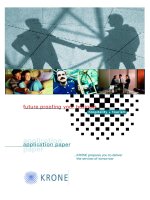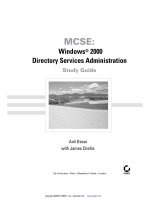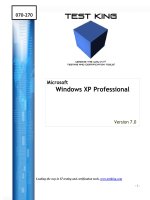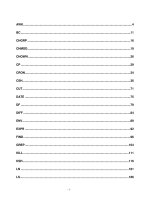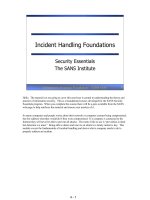Tài liệu Distributed Antenna Systems ppt
Bạn đang xem bản rút gọn của tài liệu. Xem và tải ngay bản đầy đủ của tài liệu tại đây (260.53 KB, 6 trang )
Distributed Antenna Systems
Advantages of Digital Transport in the Design, Operation
and Growth of Distributed Antenna Systems (DAS)
WHITE PAPER
Introduction
The Digivance® product line with FLEX technology has many features and
functions made possible by its use of a digital platform. This white paper
describes the distinct advantages of Digivance when contrasted with legacy
analog fiber repeaters. Topics covered include: Benefits of Digital Over Analog
Fiber Backhauls; Benefits of Digitizing RF signals; Interference Protection; and
Future-Proofing.
Digivance NXD and CXD feature the innovative FLEX technology that offers the
option of one, two, three or four 15 MHz bands in a single cabinet. This
technology also provides simulcasting -- the option of spreading the coverage of
a BTS sector across two or more transmit/receive locations. FLEX technology
allows multiple simulcast arrangements for different bands or different RF
technologies. In addition, this technology offers operators increased flexibility in
meeting fluctuating capacity demands. By allowing service providers to change
simulcast patterns through the use of remotely controlled digital cross connect
switches, FLEX technology can reallocate capacity and reduce BTS costs. This
technology can also be integrated with Software Defined Radio (SDR) to enable
wireless networks of the future.
Benefits of Digital Fiber
The Digivance system uses digital fiber for connecting the hub to the remote
units. Digital fiber has many advantages over analog including greater band-to-
band isolation, consistent RF performance with automated delay management
and integrated IP connectivity to all RANs, and accurate fiber link fault detection
and isolation.
• Band-to-Band Isolation
The multiple RF bands transported between the hub and remote unit are
digitally time-multiplexed onto the fiber backbone. Therefore, once the
signals are in the digital domain, it is not possible for one RF band to affect
another. When using analog, one band or even one signal can adversely
affect performance on all other bands on the fiber. Isolation capabilities
and performance benefits apply to both the RF and optical domains. Not
only does digital transport/multiplexing isolate signals from different RF
bands but it also provides complete isolation for signals being optically
Advantages of Digital Transport in the
of Distributed Antenna Systems (DAS)
Design, Operation and Growth
Advantages of Digital Transport
Page 3
multiplexed (via CWDM) on the same fiber. For an
analog transport system, isolation between
bands/different wireless providers is limited by the
optical filter performance of the CWDM equipment.
It must also account for varying power levels
provided by near/distant RANs. Analog optical
isolation, especially for adjacent wavelengths, is
significantly less than the RF isolation required
between the RF bands being transported.
• RF Performance
A digital fiber system will have more consistent
performance with respect to gain and noise figures
for example, the uplink noise figure on the digital
fiber will be the same at 1 mile of fiber or at 30
miles. An analog system will have increased losses
at longer fiber distances and therefore, RF
performance (e.g. dynamic range, gain, and noise
figure) will vary across the analog network. As fiber
distances increase, the performance advantage of
digital over analog increases as well.
• Delay Management
Digivance provides Automated Delay Management
features that provide a much simpler simulcast
configuration and optimization process than is
possible when using analog fiber. When
simulcasting, signals are repeated at more than one
remote node. This is an efficient way of spreading a
BTS sector over a wider geographic area with fewer
BTSes to cover larger areas. Additionally, ‘simulcast
hand-offs’ occur between adjacent simulcasted
remote nodes.
These simulcasted hand-offs do not require a
change in RF channel or timeslot and so they are
less likely to drop calls that can occur during hard
hand-offs or sector-to-sector hand-offs.
Simulcast works because the radio equipment in
mobile phone networks is designed to handle
multi-path signals. Typical multi-path is spread by
several microseconds and the radio equipment is
optimized to handle this correctly. If the multi-path
delays become much larger than this, then the
radio receivers will be adversely impacted and
performance is affected.
For optimal simulcast performance, the RF delays
to each remote must be accurate and closely
managed. If the delays between simulcasted
remotes are too far apart, when the mobile is in a
simulcast overlap area region approximately half-
way between two remotes, performance is
affected. Field-testing has shown significant
performance impact for non-optimized simulcast
delays.
Digivance has GPS receivers at all hubs and
remotes. Using these GPS receivers, Digivance is
able to measure the delay of all fiber runs with
nanosecond accuracy (usable for E911 providers to
perform location over a Digivance network). Since
Digivance uses digital fiber, the system can
automatically adjust the delays (via delay memory)
to have all signals come out of every remote with
the same delay. Therefore, a wireless service
provider never has to worry about degraded
performance when simulcasting due to non-
optimized delay.
As systems grow, the associated fiber plant
connecting the hubs to the remote nodes will
change in routing and length. In an analog
environment, these growth-driven changes can
require the operator to create new delay spools to
balance the system’s performance and delay.
However, in an analog system, as the length of the
fiber increases, the dynamic range of the system is
lower overall. With a digital system, delays can be
equalized without introducing any fiber spools and
the system can grow or change with no plant
intervention.
Likewise, if an operator wishes to change simulcast
patterns with an analog system, fiber would once
again have to be cut and re-spliced, with added or
subtracted lengths, to equalize delay between the
simulcast nodes.
• Integrated Ethernet Connectivity
Digivance provides Ethernet connectivity to all
remotes. This allows a powerful operations and
management tool for monitoring performance and
alarms at the remote units. Additionally, software
updates do not require site visits since they are
easily and automatically done over the network
connection.
• Fiber Link Fault Detection and Isolation
Digivance fault management software continually
monitors the fiber interface health and immediately
reports any degradation in performance. In the
event of a failure, the fault management software
identifies the failed module requiring replacement.
Degradation in fiber connectivity (excluding an
abrupt cut) is detected digitally before the effects
are visible in the RF airlinks. Digital fiber error rates
are well below 10-6 while the hosted airlink is
designed for <10-2. Analog fiber systems, like the
hosted RF waveforms, will detect fiber problems
only when the effect is great enough to already
degrade the airlink.
Advantages of Digital Transport
Page 4
Digitized Signals
Digivance digitizes the RF signals by band for transport
over the fiber backbone. Digitizing of the signals has the
following benefits: high spur-free dynamic range, simple
and reliable simulcast configurations, and digital
switching.
• Spur-Free Dynamic Range
Using high performance 14-bit analog-to-digital
and digital-to-analog converters, Digivance is able
to achieve spur-free dynamic ranges of greater then
70 dB. Additionally, each band is independently
digitized to insure that only signals in the selected
band go into the digitizers. Because of the
independence of the digitizers, the total dynamic
range across all the bands is 90 dB. Likewise, with
each frequency block maintaining its independence,
any gain control used to eliminate strong signals
will not affect any other frequency block. Analog
repeaters claim 70 dB SFDR. However, in an analog
fiber system, multiple bands are combined onto the
same fiber, which can lower the overall dynamic
range. Also, any gain control system employed to
deal with the presence of strong signals in one
band will necessarily affect all other bands. The
alternative is to disable gain control and allow
intermodulation products to randomly affect
performance.
• Simulcast Configurations
The Digivance digital platform provides many
simulcast configuration benefits, as it is an integral
part of the platform. All simulcast configurations
are done at the hub location using CAT-5 patch
cables (similar to a computer network room).
Analog systems require separate RF combiners,
splitters and cabling to perform simulcasting.
Reconfiguring the simulcast on an analog system
would require different splitters and combiners
based on the new simulcast configurations.
Digivance downlink simulcast splitting is done
digitally (an exact copy of the digitized signals are
sent to all remotes). Therefore, there is no impact
on the downlink signals. In an analog system,
splitters are used that add loss to the downlink
signals (lowers signal to noise). Digivance uplink
signals are combined digitally for predictable
simulcast combining. In an analog system, RF
combiners are used that have more variability as to
how the signals are combined.
• Digital Switching
Band independent simulcast/capacity re-allocation
can be easily added to a digital transport system.
Digivance provides the option of a fully software
controlled digital cross-connect switch to allow
wireless operators to easily reconfigure capacity
distribution within their DAS network. Because of
its digital nature there is no performance impact
with the inclusion of the switch within the network.
The addition of a switch within an analog DAS
network will necessarily degrade dynamic range
since the analog switches performance (IP3, noise
figure, band to band isolation) cascades with that
of the remote unit(s) and the host base station. The
superior isolation of a digital transport also allows
switching operations within each band/wireless
operator to be completely independent and
transparent with no performance compromises.
Advantages of Digital Transport
Page 5
Interference Protection
The Digivance FLEX platform, using a NXD, allows co-
location of up to eight wireless service providers over
nine different frequency bands (SMR, Cell-A, Cell-B and
PCS A-F). In order to support all these different bands
and not have them interfere with one another, a great
deal of attention was given to the isolation of the various
bands (transmit-to-transmit, transmit-to-receive). This
was successfully demonstrated and confirmed by
independent third party testing. The same interference
protection is used in all Digivance with FLEX platform
products.
Additionally, Digivance is designed to prevent
maintenance actions in one band from affecting service
in another. This is accomplished by partitioning of bands,
individually digitizing each band and having all modules
be hot swappable. In an analog repeater, if one band
needs maintenance, then all bands serviced by that
remote are affected.
Future-Proofing
As in most high-tech areas, digital is the future. Not only
does digital operate more predictably and reliably, the
cost of digital technology is often on a much steeper
curve (Moore’s Law) than that of analog. For example,
over the last few years we have seen 2 Gbps digital lasers
give way to 10 Gbps and now 40 Gbps lasers. This
increase in digital fiber capability allows more efficient
use of fiber. And since fiber does not drop in cost as
quickly as the technology being used on it, the improving
digital technology has a larger impact on lowering the
cost of digital DAS networks.
Additionally, in the next few years, base stations and
software radios will use a digital interface to RF modules.
This will make it easy to move the digital DAS system to
this new interface and recoup benefits such as cost
savings and simplification. Analog systems will still require
the old analog BTS interface with its added cost and
complexities.
Authors:
John Sabat,
Director of Engineering Research
and
Thomas Hebert,
Manager of Systems Engineering



